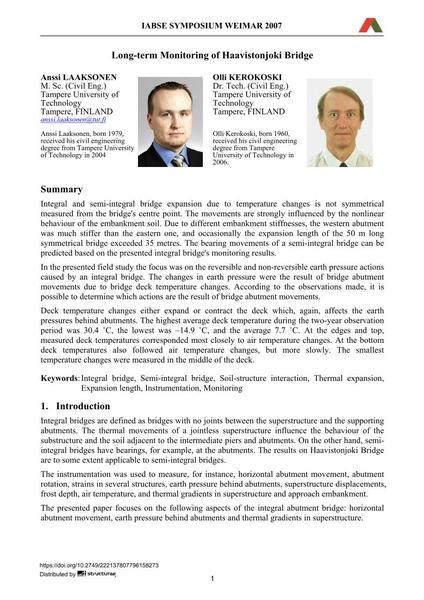Long-term monitoring of Haavistonjoki Bridge

|
|
|||||||||||
Bibliografische Angaben
| Autor(en): |
Anssi Laaksonen
Olli Kerokoski |
||||
|---|---|---|---|---|---|
| Medium: | Tagungsbeitrag | ||||
| Sprache(n): | Englisch | ||||
| Tagung: | IABSE Symposium: Improving Infrastructure Worldwide, Weimar, Germany, 19-21 September 2007 | ||||
| Veröffentlicht in: | IABSE Symposium Weimar 2007 | ||||
|
|||||
| Seite(n): | 360-361 | ||||
| Anzahl der Seiten (im PDF): | 6 | ||||
| Jahr: | 2007 | ||||
| DOI: | 10.2749/222137807796158273 | ||||
| Abstrakt: |
Integral and semi-integral bridge expansion due to temperature changes is not symmetrical measured from the bridge's centre point. The movements are strongly influenced by the nonlinear behaviour of the embankment soil. Due to different embankment stiffnesses, the western abutment was much stiffer than the eastern one, and occasionally the expansion length of the 50 m long symmetrical bridge exceeded 35 metres. The bearing movements of a semi-integral bridge can be predicted based on the presented integral bridge's monitoring results. In the presented field study the focus was on the reversible and non-reversible earth pressure actions caused by an integral bridge. The changes in earth pressure were the result of bridge abutment movements due to bridge deck temperature changes. According to the observations made, it is possible to determine which actions are the result of bridge abutment movements. Deck temperature changes either expand or contract the deck which, again, affects the earth pressures behind abutments. The highest average deck temperature during the two-year observation period was 30.4 °C, the lowest was –14.9 °C, and the average 7.7 °C. At the edges and top, measured deck temperatures corresponded most closely to air temperature changes. At the bottom deck temperatures also followed air temperature changes, but more slowly. The smallest temperature changes were measured in the middle of the deck. |
||||
| Stichwörter: |
Dehnlänge Boden-Bauwerk-Interaktion integrale Brücke semi-integrale Brücke semiintegrale Brücke Monitoring
|
||||
